
The old kingdom
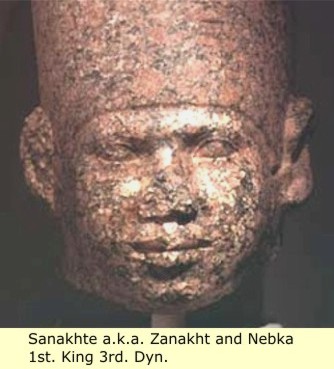 Sanakhte
Sanakhte
So now, we are back in Egypt and by now Egypt has been moving right along, it has gone through two dynasties and many kings. Its religion has become more refined, its society even more organized, and much more affluent. We start with Sanakhte, uncertainty swirls around the placement, and also the events of the 3rd Dynasty king known as Sanakhte (Sanakht). He may have been Nebka, who was known to manetho, and listed on both the Turin Cannon and the Abydos king list as the first king of this dynasty. However, this is problematic to say the least, for we base our belief that he was Nebka on a source that lists his Horus name Sanakhte, together with a second name that ends with the element "ka".
Most of the information we have on this king refers to him as Nebka. In fact, some sources list the two as separate kings, with Nebka founding the 3rd Dynasty and Sanakhte ruling later, perhaps after Khaba However, despite this, mud seal impressions bearing the name of Nethery-khet Djoser from the Abydos tomb of the last king of the 2nd Dynasty Khasekhemuy and connected with the burial seem to suggest that Khasekhemuy's widow and her already ruling son Djoser were in charge of the king's burial. On the basis of sealing from the tomb of Khasekhemwy, which name her as "Mother of the King's Children," the wife of the last ruler of the 2nd Dynasty seems to have been one Nimaethap.By now, the king of Egypt has the wealth and power to undertake monumental building projects. And so it is, that Netjerikhet Djoser (Zoser), the second King of Egypt's 3rd Dynasty, and his grand vizier and architect "Imhotep" set about to build the first Monumental stone structure ever created, the Step Pyramid.
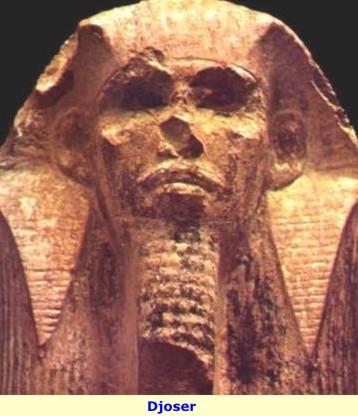 |  |
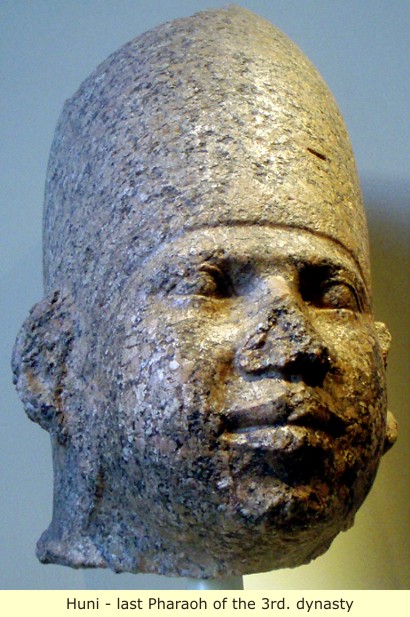 |
The quality of this photograph is poor, because it is a very old B&W photograph which had to be enlarged. |
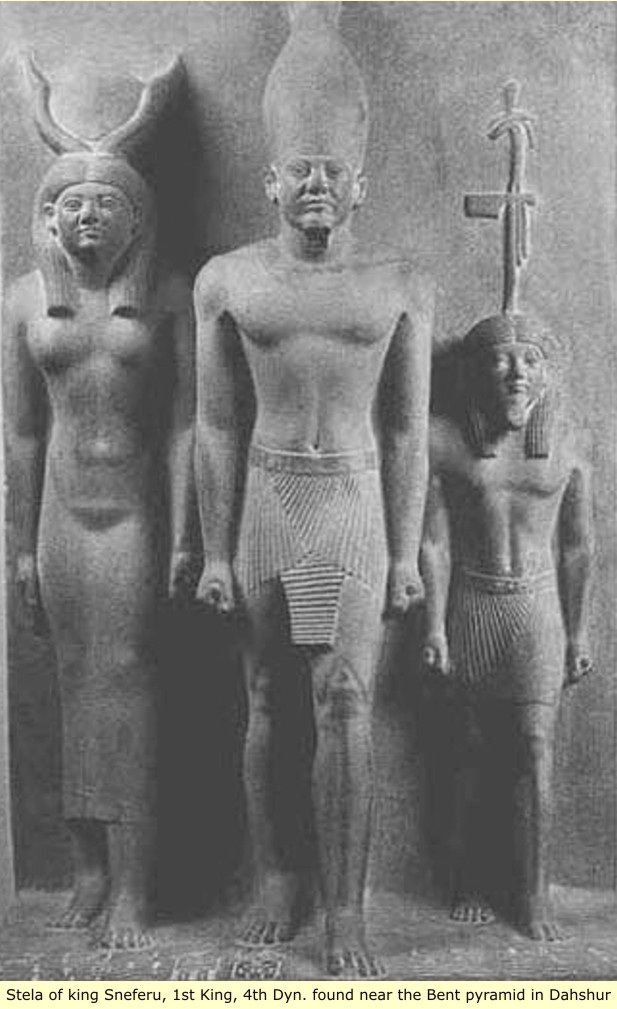 |
Here is a modern picture of the same stela, as it sits in the Cairo Museum. Funny thing though, now it is said to be Menkaure, 5th king of the fourth dynasty, and the Nose is different. What are we to make of this? Seems "Improvements" were made over the years, but is that legal? (Tongue firmly in Cheek). The Turks in Egypt are just full of surprises! |
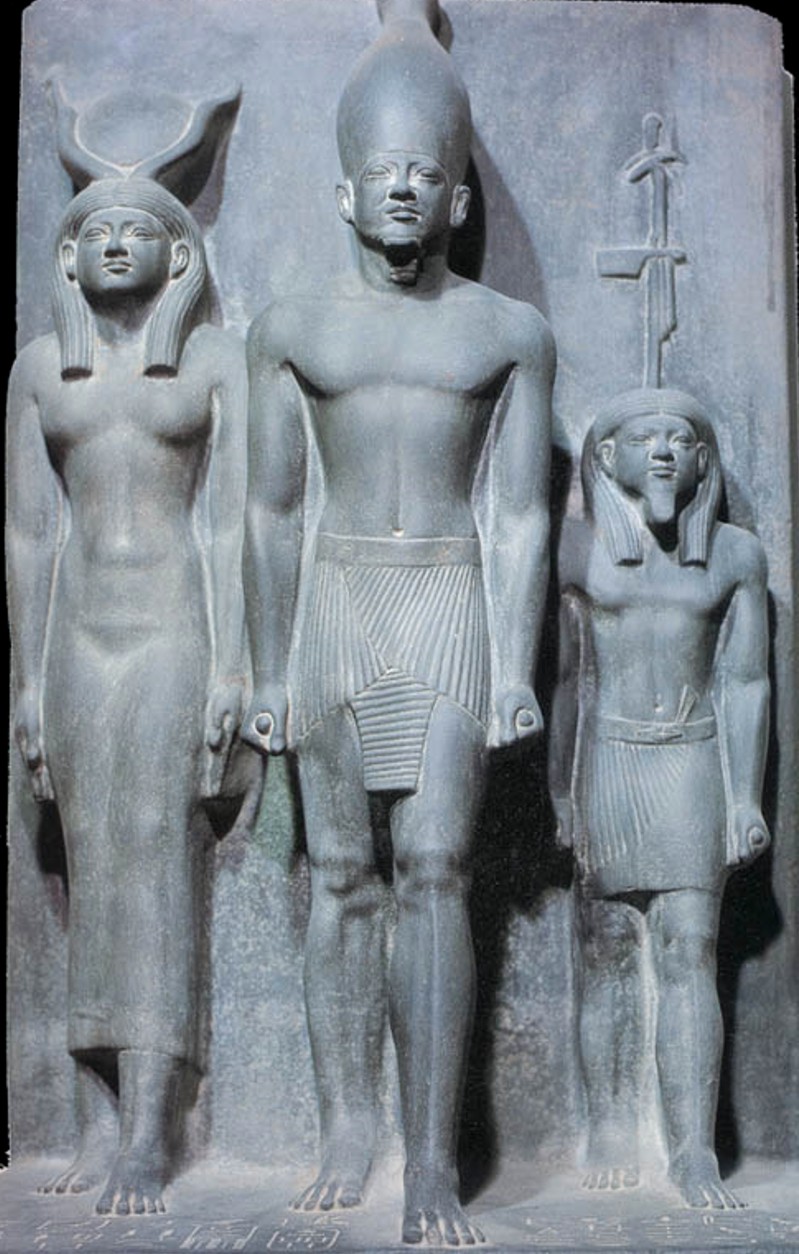 |
However, it will be Djosers grandson Khufu, 2nd king of the 4th dynasty, {no one is sure why the kingship of Sneferu, caused a new dynasty to begin}, who will became Egypt's best-known pyramid builder. For it is he, who will build the Great Pyramid at Giza.
 |  |
Herodotus, (who wrote his histories and commentaries on Egypt around 450 B.C, centuries after Khufu had reigned around 2585 B.C.), recorded this about the King:
"Kheops brought the country into all kinds of misery. He closed the temples, forbade his subjects to offer sacrifices, and compelled them without exception to labor upon his works. The Egyptians can hardly bring themselves to mention Kheops so great is their hatred." It was even said that Khufu sent one of his daughters into a brothel so that she could raise revenue to build the pyramid, also asking each client for a block of stone so she could build her own pyramid. No evidence exists for such a story, though there are smaller pyramids, which probably belonged to the half-sister/wives of Khufu, and he did have at least three daughters of record.
It is also from his time that we know that Egyptians had ships capable of trans-continental travel, many of these ships {150 ft. in length}, were found buried in Khufu's tomb.
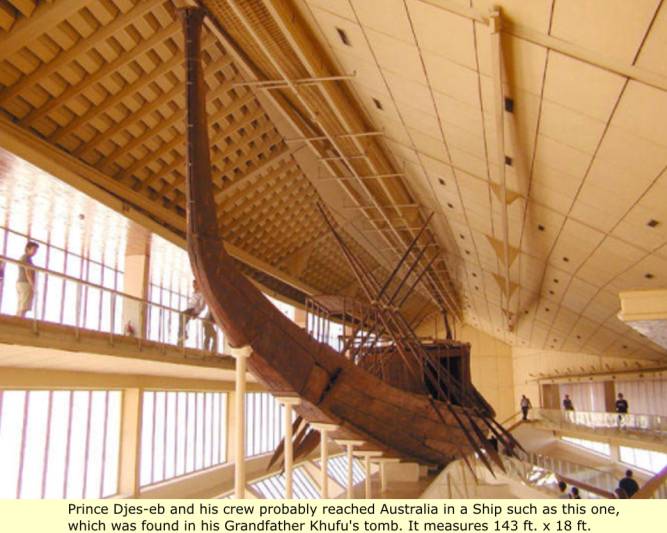 |
In Australia, there is a stella and writings chronicling the trials and travails of Khufu's grandson "Prince Gjes-eb", who had been shipwrecked in Australia. The chronicle tells of how the prince had been bitten by a poisonous snake and died, and that the rest of the crew was without hope. But, something really curious here, in the chronicle the writer says, "For two seasons he made his way westward, weary, but strong to the end". Where could they have been coming from, where after "two seasons", they had still only made it to as far west as Australia? Click here for the full text of the Egyptian Ship-wreak in Australia. <<Click>>
We don't know why Whites, and their Turkish co-conspirators in Egypt, like the Egyptian antiquities Minister Hawass, like to pick on the family of king Sneferu/Snofru for their falsifications. (Hawass famously said that Egyptians weren't Black, they were, er something else: Martians maybe?). In the Prehistoric page, we demonstrated how Whites and their co-conspirators, the Turks of Egypt: found a "Headless" statue of Hemiunu, Sneferu's grandson, they then placed a new head on it with a White mans face, and declared it an "Authentic" artifact. Now here is their latest outrage against our intelligence, they want us to believe that the face of Sneferu's seventh son Ranefer, seen below, is authentic.
The Father - king Sneferu/Snofru | The Brother - king Sneferu's first son Khufu | king Sneferu's seventh son Ranefer???? |
 |  |  |
Of course, there is now way that face could belong to king Sneferu's seventh son Ranefer. So what happened? Liars rarely have much imagination, so they continually do the same things, and so it is with Ranefer's statue. As with Hemiunu's statue, those pathetic liars simply placed a head with a White face on it. Note the fuller pictures of Ranefer's statues below, both show signs of head replacement/modification.
 |
 |  |  |
Khafre
As with many of the very earliest Pharaoh's, even though they may have left some of the grandest of all monuments in Egypt, they left little in the way of inscriptions, and so we know very little about them. Khafre (Chephren), the builder of the second pyramid on the famous Giza Plateau near Cairo is a fine example. His birth name was Khafre, which means "Appearing like Re". He is also sometimes referred to as Khafra, Rakhaef, Khephren or Chephren by the Greeks, and Suphis II by Manetho. He was possibly a younger son of Khufu (Cheops) by his consort, Henutsen, so he was required to wait out the reign of Djedefre, his older brother, prior to ascending to the throne of Egypt as the fourth ruler of the fourth Dynasty.  |
However, there is disagreement on this matter. There are rumors of a problem with the succession of Khafre. Some authorities maintain that Djedefre may have even stole the throne, perhaps as a younger brother of Khafre, and that Khafre may have even murdered him. Much of this speculation originates from the fact that Djedefre broke with the Giza burial tradition, electing instead to locate his tomb (pyramid) at Abu Rawash. However, there is little real evidence to support such a conclusion, and in fact, Khafre continued Djedefre’s promotion of the cult of the sun god Re, by using the title “ the Son of the Sun” for himself and by incorporating the name of the god in his own.
We will end the 4th dynasty by mentioning that The last and smallest of the Great Pyramids at Giza was built by pharaoh Menkaure, 5th king of the fourth dynasty.
 |


 |
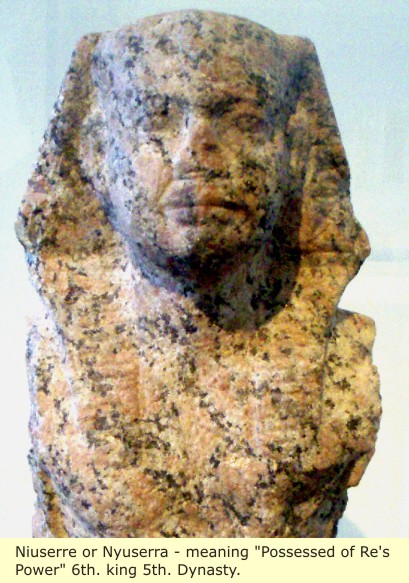 | 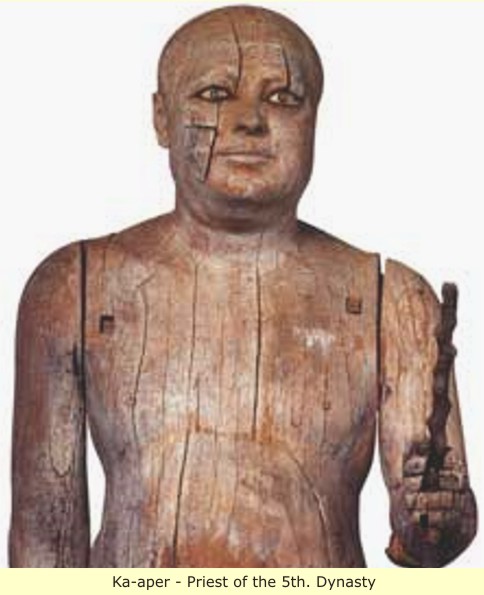 |
It is with the beginning of the 6th dynasty, that the groundwork is laid for the problems to come. There was apparently accession problems following the death of King Unas, last king of the 5th dynasty. It is believed that Teti, 1st. king of the 6th. dynasty, secured his position by marrying one of king Unas's daughters "Iput I". The length of Teti's reign is sometimes given as 13 years and other sources list it as 33 years. In any event, according to the Manetho, the king was murdered by his guards for mysterious reasons.
The accession of his son Pepi, seems to have been held up by a usurper named Userkare. His reign was short-live however, and Pepi ascended the throne after about one year. When Pepi ascended the throne he was still quite young and his mother Iput I, may have acted as his regent, he reigned for about 50 years. In about year 42 of his reign, there was apparently a harem conspiracy against his life, by one of his queens named "Were-Imtes". Some say that it was not one of his queens behind the plot, but rather the mother of the usurper Userkare. In any event the plot was uncovered, and the plotters punished.
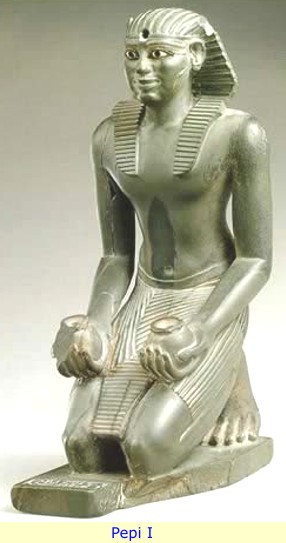

During Pepi's reign, there was apparently many disturbances in Canaan. Five campaigns are attested to by this inscription in the tomb of Weni the Elder.
His majesty sent me to lead this army 5 times to subdue the land of the Sand Dwellers, every time they rebelled, with these troops. I acted so that his majesty praised me for it. Told that there were rebels amongst these foreigners at the 'Nose-of-the-Gazelle's-head' I crossed in ships, together with these troops. I put to land at the back of the height of the mountain range to the north of the land of the Sand-Dwellers, while (the other) half of this army were traveling by land. I turned back, I obstructed all of them and slew every rebel amongst them.
From the autobiography of Weni the Elder

An indication of the unsettled nature of Pepi I's reign, is the duties of one "Nankhpepi", who was the supervisor of Upper Egypt, and chancellor of the king of Lower Egypt, plus the governor of the fourteenth Nome of Upper Egypt. Apparently along with the beautiful backpack, he also wore many hats.
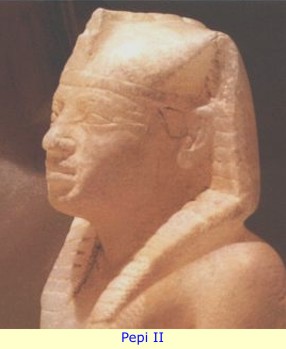 Upon his death, Pepi I was succeeded by his eldest son Merenre I, who died unexpectedly. He was succeeded by his younger half brother, Pepi II. His reign of possibly 94, (some Egyptologist believe 64), years was the longest in ancient Egyptian history. He seems to have come to the throne at about the age of six, and would therefore have lived until the age of one hundred.
Upon his death, Pepi I was succeeded by his eldest son Merenre I, who died unexpectedly. He was succeeded by his younger half brother, Pepi II. His reign of possibly 94, (some Egyptologist believe 64), years was the longest in ancient Egyptian history. He seems to have come to the throne at about the age of six, and would therefore have lived until the age of one hundred.Pepi II maintained diplomatic and commercial relations with Canaan, and made several trips and campaigns south to pacify Nubia. There were also many trading expeditions into central and east Africa.
Upon his death Pepi II may have been succeeded by a son named Merenre II, but perhaps for only one year. According to Manetho, he was married to a Queen Nitocris, who succeeded her husband to become the last ruler of the 6th Dynasty. However, very little archaeological evidence of Merenre II, or Nitocris exists.
The Turin Papyrus places 'Nitocris' after Pepi II and possibly Merenre II and an unknown pharaoh towards the end of the 6th dynasty. This 'Nitocris' is also mentioned by both Herodotus and Manetho as a queen, but cannot be identified with any historical pharaoh. These events reported by Herodotus cannot be verified and may be fanciful.
Herodotus:The name of the woman who reigned was the same as that of the Babylonian queen, namely Nitocris.
Of her, they said that desiring to take vengeance for her brother, whom the Egyptians had slain when he was their king and then, after having slain him, had given his kingdom to her,--desiring I say, to take vengeance for him, she destroyed by craft many of the Egyptians. For she caused to be constructed a very large chamber under ground, and making as though she would inhabit it but in her mind devising other things, she invited those of the Egyptians whom she knew to have had most part in the murder of her brother, and gave a great banquet. Then while they were feasting, she let in the river upon them by a secret conduit of large size.
Of her they told no more than this, except that, when this had been accomplished, she threw herself into a room full of embers, in order that she might escape vengeance.
Of her, they said that desiring to take vengeance for her brother, whom the Egyptians had slain when he was their king and then, after having slain him, had given his kingdom to her,--desiring I say, to take vengeance for him, she destroyed by craft many of the Egyptians. For she caused to be constructed a very large chamber under ground, and making as though she would inhabit it but in her mind devising other things, she invited those of the Egyptians whom she knew to have had most part in the murder of her brother, and gave a great banquet. Then while they were feasting, she let in the river upon them by a secret conduit of large size.
Of her they told no more than this, except that, when this had been accomplished, she threw herself into a room full of embers, in order that she might escape vengeance.
 |  |
The First Intermediate Period
It is always the case, that when there is a king of extraordinary length of reign, the result will be weak kings to follow and eventually chaos. The demise of the 6th dynasty, because of dissension and weak kings, marks the onset of what is called, the First Intermediate Period. These intermediate periods, are times when Egypt is not a united country, but rather independent cities or regions. In these periods, the term dynasty is assigned to the kingship lines that have the most power, or sometimes to a group of disparate rulers.
 |  |  |

The end of the Old Kingdom brought on a period of chaos, bloodshed and anarchy. Resulting from the collapse of the monarchy, and the rivalries of the provincial feudal lords or 'nomarchs'.
This situation may also have been fomented by Asiatic's, who had infiltrated into the Delta (northern Egypt). From the beginning, Egyptian kings had gone into Canaan to subdue people who they variously called, Troglodytes, San dwellers or vile Asiatic's. It appears that at this time, these people are making a concerted effort to breed dissension in Egypt. However in this case, it is unclear if these mischief-makers are native Canaanite's or Amorites from the desert.
Things continued this way throughout the Seventh Dynasty (2181-2173 B.C.). During this brief period, over 70 rulers were said to have laid claim to the throne of Egypt. The Eighth Dynasty (2173-2160 B.C.), followed the same pattern. Civil disorders multiplied, and then a drought struck Egypt. Valuable insight into this period can be gleaned from a papyrus in the Leyden collection, called "Admonitions of an Egyptian Sage". Excerpts from the papyrus follows..
Admonitions of an Egyptian Sage
The bowman is ready. The wrongdoer is everywhere. There is no man of yesterday. A man goes out to plow with his shield. A man smites his brother, his mother's son. Men sit in the bushes until the benighted traveler comes, in order to plunder his load. The robber is a possessor of riches. Boxes of ebony are broken up. Precious acacia-wood is left asunder.
{The general upheaval has reversed the status of rich and poor:}
He who possessed no property is now a man of wealth. The poor man is full of joy. Every town says: let us suppress the powerful among us. He who had no yoke of oxen is now the possessor of a herd. The possessors of robes are now in rags. Gold and lapis lazuli, silver and turquoise are fastened on the necks of female slaves. All female slaves are free with their tongues. When their mistress speaks it is irksome to the servants. The children of princes are dashed against the walls.
Out of the turmoil and weak Kingships, principalities within the realm rose up to challenge the authority of these weak kings. One Achthoes, the ruler of Heracleopolis, seized control of Middle Egypt, and founded the Ninth Dynasty of lower Egypt (2160-2130 B.C.).
 |
Troop of Egyptian Soldiers - From the Asyut tomb of Prince Mesehti - 11th dynasty |
These kings of Heracleopolis maintained control over lower (northern) Egypt, through the Tenth Dynasty (2130-2040 B.C.). Meanwhile, the rulers of Edfu and Thebes, fought over control of Upper Egypt. The battle over Upper Egypt was won by Thebes and its ruler Inyotef Sehertowy, founded the Eleventh Dynasty (2133 B.C.), with the aim of extending his power over all the land. There ensued a north-south battle for control of Egypt, which ended with the victory of Nebhepetre Mentuhope II, who re-united the country under one king, and launched the period known as the Middle Kingdom.
The Middle Kingdom
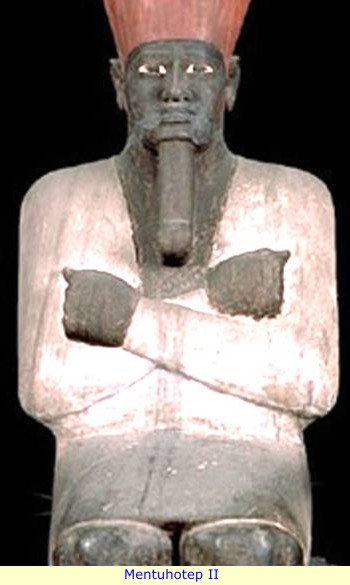
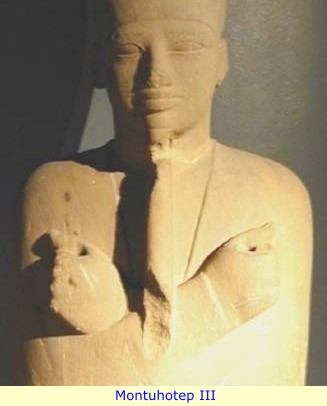
Montuhotep II
Montuhotep II was king for about 50 years, though much of his reign involved military campaigns, some building work was done. His greatest building work however, was his own temple and tomb, located on the west bank at Thebes. It is located in the cliffs at Deir el-Bhari, next to the famous temple of Queen Hatshepsut.
 Rebuilding from the second intermediate period, was only begun in earnest by his son and successor, Montuhotep III. He demonstrated a preference for the arts as well as building. He also reopened trade with the Red Sea region.
Rebuilding from the second intermediate period, was only begun in earnest by his son and successor, Montuhotep III. He demonstrated a preference for the arts as well as building. He also reopened trade with the Red Sea region.Amenemhet I
But it was Amenemhet I, the first ruler of the 12th Dynasty, (who may have been a usurper), that some Egyptologists credit with the full recovery from the First Intermediate Period and the transition into the Middle Kingdom. Which was a period of great prosperity.Amenemhet I appears to have been a wise leader, he set about to correct the problems of the First Intermediate Period, and he took steps to protect Egypt's boarders from invasion and to assure a legitimate succession, {he was the first king to establish a co-regency with his son, Senusret I}. Yet he was murdered in an apparent harem plot, while his co-regent was leading a campaign in Libya. We find two literary works, the Tale of Sinuhe, and the Instructions of Amenemhet I, reflecting this king's tragic end. One literary work from the time of his son Senusret I, presents the account of Amenemhet I's murder, supposedly provided by the king himself from beyond the grave:
It was after supper, when night had fallen, and I had spent an hour of happiness. I was asleep upon my bed, having become weary, and my heart had begun to follow sleep. When weapons of my counsel were wielded, I had become like a snake of the necropolis. As I came to, I awoke to fighting, and found that it was an attack of the bodyguard. If I had quickly taken weapons in my hand, I would have made the wretches retreat with a charge! But there is none mighty in the night, none who can fight alone; no success will come without a helper. Look, my injury happened while I was without you, when the entourage had not yet heard that I would hand over to you when I had not yet sat with you, that I might make counsels for you; for I did not plan it, I did not foresee it, and my heart had not taken thought of the negligence of servants.
Senusret I
Apparently, his foresight in creating the co-regency with his son proved successful, for Senusret I, succeeded his father, and there seems to have been little or no disruption in the administration of the country. For this is first time that we know of in Egyptian history that a prince, Senusret I, was made a co-regent in the 20th year of Amenemhet I's rule, and so was by the time of his father's death he was firmly established as the heir to the throne. Therefore, regardless of the intentions of the conspirators, he managed to ascend the throne with little difficulty.Senusret I probably ruled Egypt for a period of about 34 years after his father's death. This was a period in Egypt's history where literature and craftsmanship was at its peek. We believe he may have been a co-regent with his father for perhaps ten years. He probably ruled Egypt from about 1956 through 1911 B.C. It was a period of affluence, and a remarkable time for mineral wealth, gold and fine jewelry was produced in abundance. Jewelry masterpieces have been found, particularly in the tombs of the royal ladies at Dahshur and Lahun, attributable to his reign.
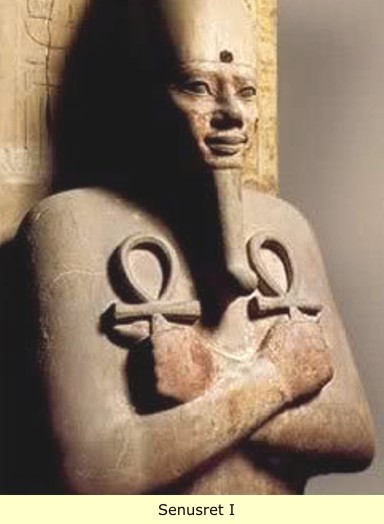 |  |  |
Amenemhet II
Amenemhet II was the son of Senusret I and one of his chief queens, Nefru. He was the third ruler of Egypt's 12th Dynasty. Like his father, he served the first part of his reign as co-regent (perhaps for only two years) with Senusret I. His co-regency may have been short, but we are told that during this co-regency Amenemhet II led a Nubian expedition. Apparently, Amenemhet II also took his son - Senusret II as a co-regent, but also for only a brief time before his own death. Amenemhet II apparently ruled Egypt for a period of some 30 years after his co-regency. The Oxford History of Ancient Egypt gives his reign as lasting from 1911 through 1877 B.C
 |
Amenemhet II, grandson of Amenemhet I, continued the recovery by reestablishing Egypt's prominence in foreign affairs and trade. Recovered artifacts attest that he exchanged gifts with other rulers in the Mediterranean region. We find jewelry inscribed with his name in royal tombs at Byblos in Canaan. Bronze boxes found at the temple of Montu at Tod inscribed with his name, contained a large number of silver cups of Aegean origin. Also found were cylinder seals and lapis Lazuli amulets from Mesopotamia. In addition, Egyptian artifacts from this period has been found in Crete at Knossos, and Minoan pottery, called Kamares ware, has been found in a tomb at Abydos in Egypt.
Senusret II
Senusret II, the birth name of the fourth king of Egypt's 12th Dynasty means "Man of Goddess Wosret". It was the name that seems to enter the royal linage because of this king's non-royal, great, great grandfather, the original Senusret and father of the founder of the Dynasty, Amenemhet I. Senusret II's name is also found in various references as Senwosret II, or the Greek form, Sesostris II.
 |  |
Senusret III
Senusret III's predecessors, had not been extremely active in Nubia militarily, and some Nubian groups had gradually been moving north, past the Third Cataract. Accordingly, Senusret III initiated a series of devastating campaigns in Nubia very early in his reign (perhaps year 6), in order to secure his southern borders and protect the trading routes and mineral resources. Apparently the Nubians were a troublesome lot during his reign, for Senusret III would again have to mount campaigns in at least the years 8, 10, 16 and 19 of his reign.
Regardless, these campaigns seem to have been for the most part successful, for the king had inscribed on a great stele at Semna, erected in year 8 of his rule - now in the Berlin museum - "I carried off their women, I carried off their subjects, went forth to their wells, smote their bulls; I reaped their grain, and set fire thereto". In other words, he killed their men, enslaved their women and children, burnt their crops and poisoned their wells. The stele also provides that no Nubians were allowed to take their herds or boats to the north of the specified border. To facilitate these military actions in Nubia, he had an existing bypass canal around the First Cataract (rapids) at Aswan, originally dug in Old Kingdom time by Merenre, and which Pepi I had cleared, broadened and deepened it.
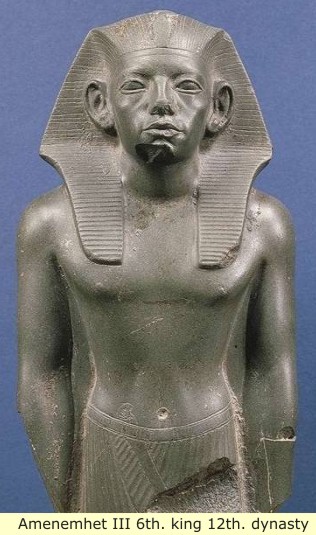
Amenemhet III
Amenemhet III was the son of Senusret III and the last great ruler of the Middle Kingdom. Amenemhet III appears to have shared the throne with is father as co-regent for at least a while before the death of his father. The king's principle wives were buried in his pyramid at Dahshur in their own chambers, a very unusual feature at this time. The Chief wife was probably Aat. The second queen we are unsure of. We also know of a daughter named Neferuptah and of course his successor who was probably his son, Amenemhet IV. However, Amenemhet IV may have been a grandson, but in any event, Amenemhet III probably made him a co-regent. It is also possible that the queen who ruled as the last pharaoh of the 12th Dynasty - Sobkhotpe IV, was also his daughter.
Amenemhet IV
This seventh king of the 12th Dynasty was probably the son of Amenemhet III. He co-ruled with Amenemhet III and a temple at Medinet Madi in the Faiyum was probably built by both kings. Due to his father’s long reign, Amenemhet IV was old when he assumed the throne. He had no male heir and was succeeded by his sister, Neferusobek.
No comments:
Post a Comment